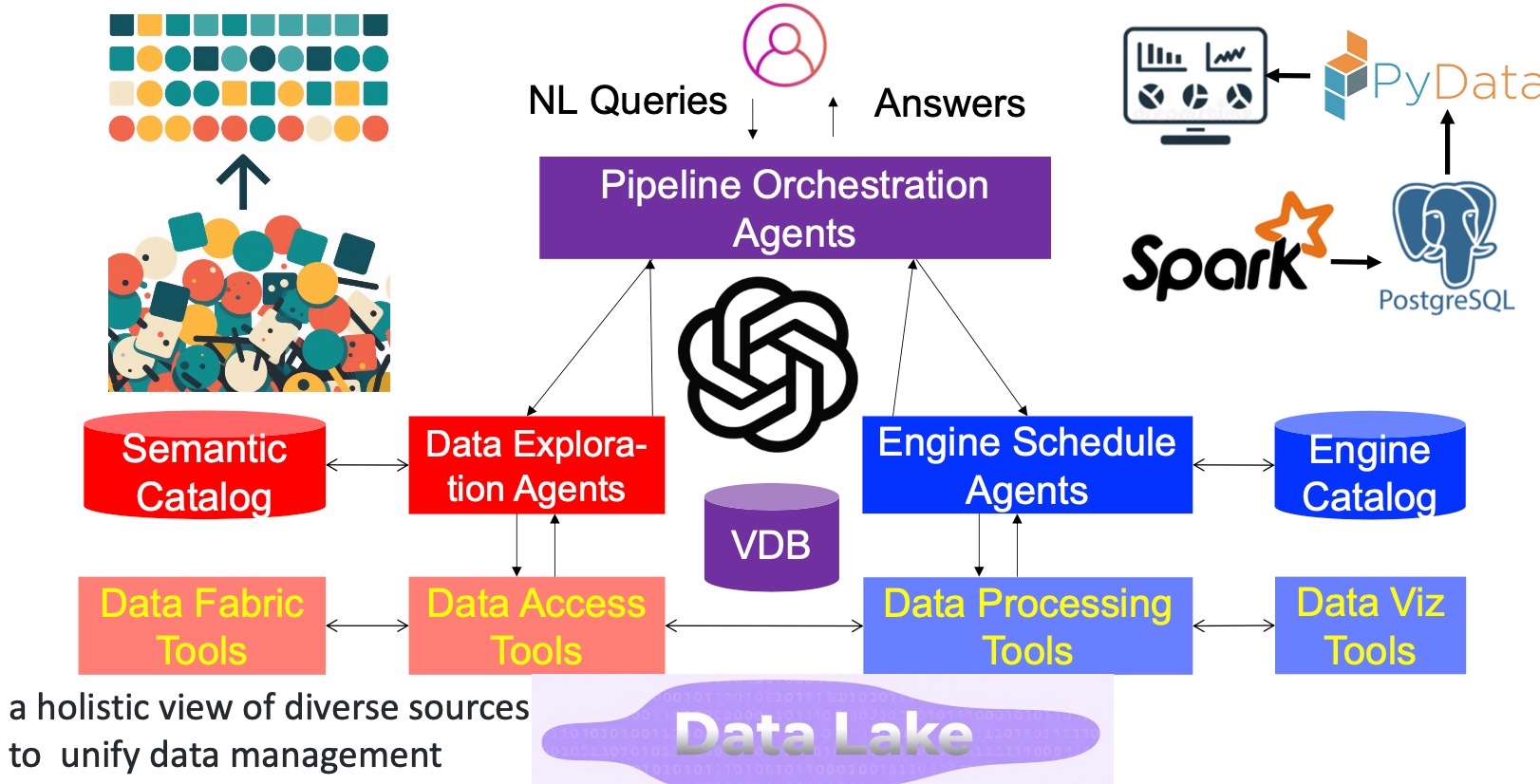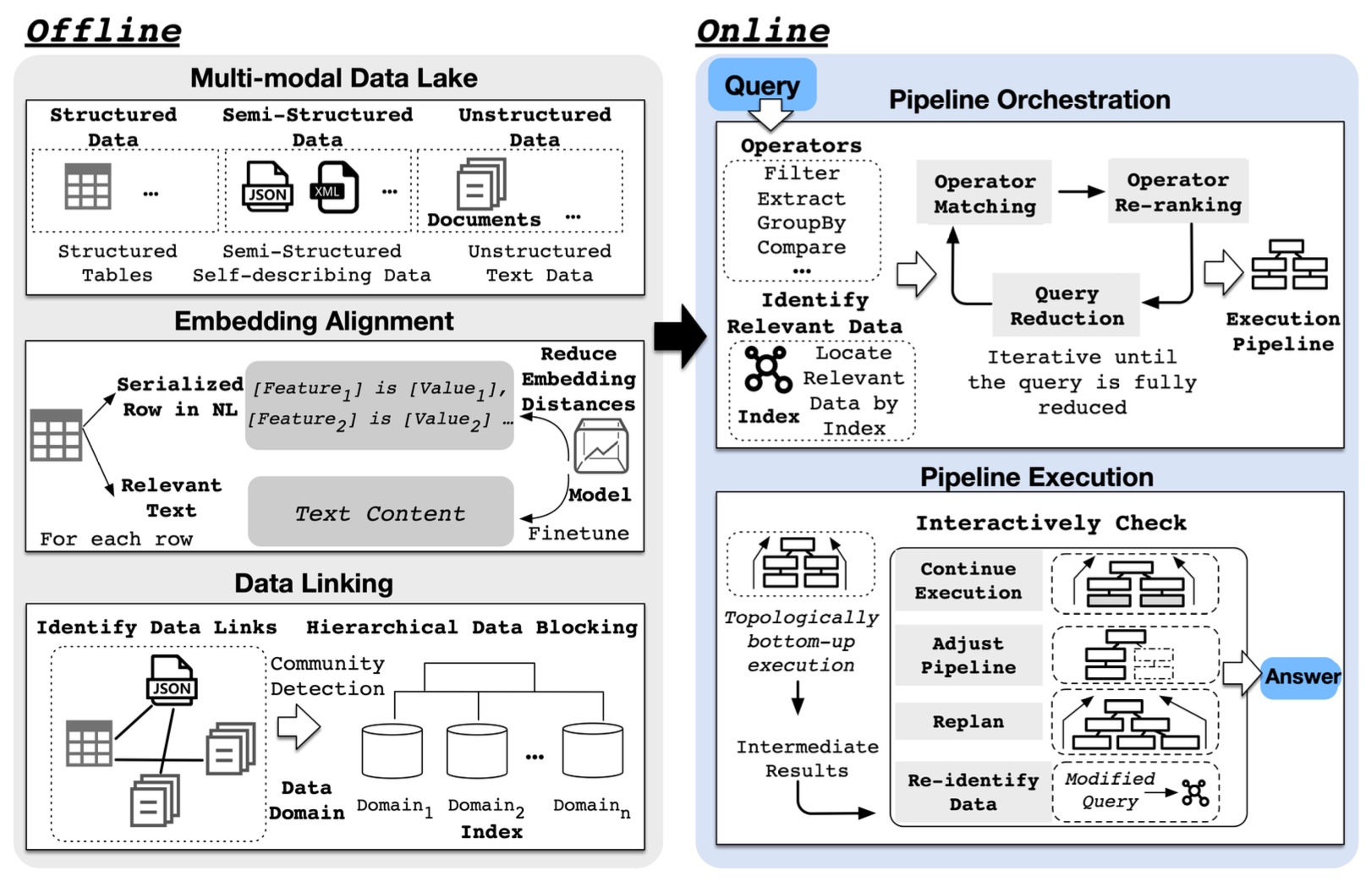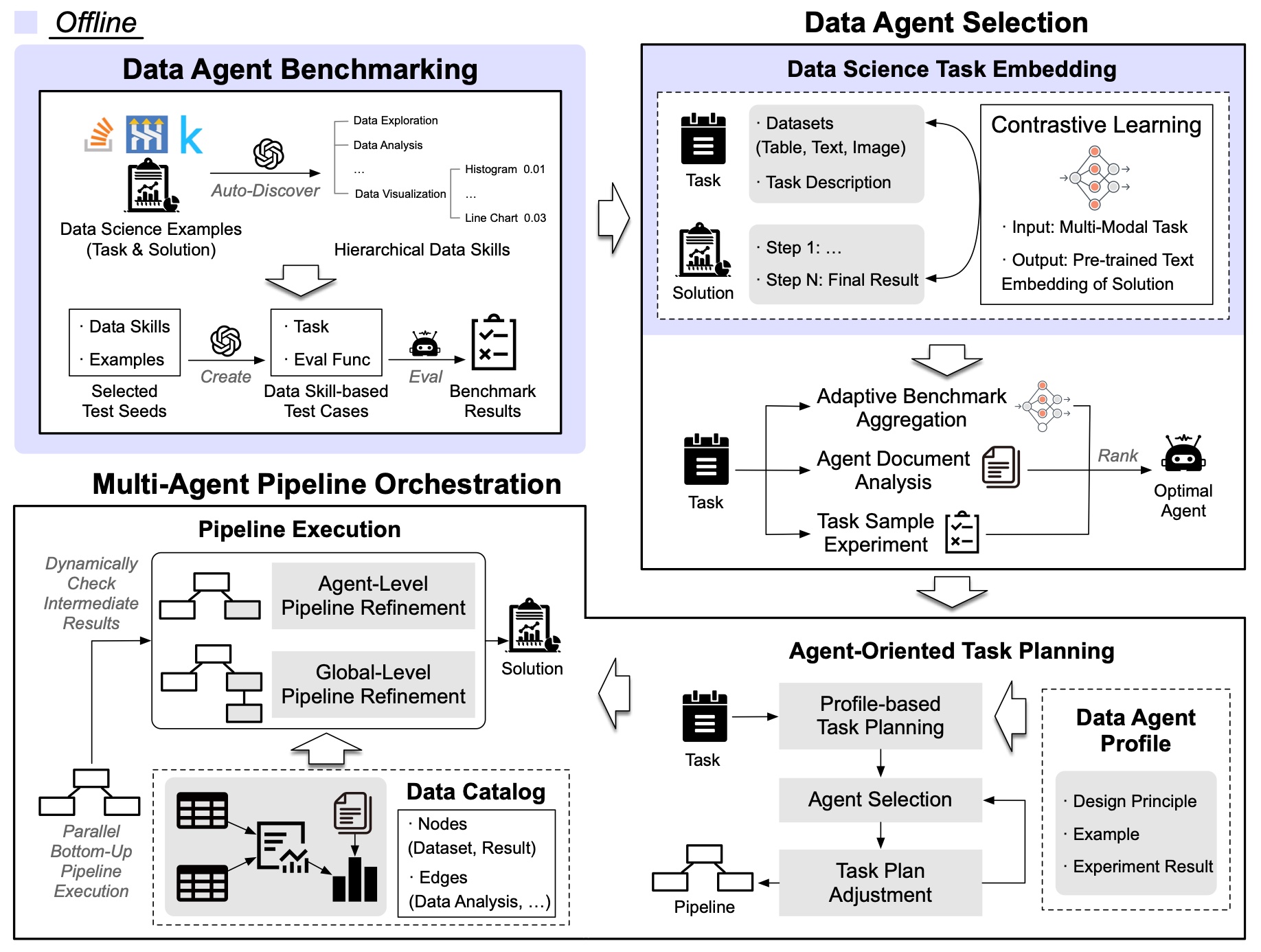
Data Agent: A Holistic Architecture for Orchestrating Data+AI Ecosystems
Motivation
Traditional Data+AI systems utilize data-driven techniques to optimize performance, but they rely heavily on human experts to orchestrate system pipelines, enabling them to adapt to changes in data, queries, tasks, and environments. For instance, while there are numerous data science tools available, developing a pipeline planning system to coordinate these tools remains challenging. This difficulty arises because existing Data+AI systems have limited capabilities in semantic understanding, reasoning, and planning. Fortunately, we have witnessed the success of large language models (LLMs) in enhancing semantic understanding, reasoning, and planning abilities. It is crucial to incorporate LLM techniques to revolutionize data systems for orchestrating Data+AI applications effectively.
To achieve this, we propose the concept of a Data Agent -- a comprehensive architecture designed to orchestrate Data+AI ecosystems, which focuses on tackling data-related tasks by integrating knowledge comprehension, reasoning, and planning capabilities. We delve into the challenges involved in designing data agents, such as understanding data/queries/environments/tools, orchestrating pipelines/workflows, optimizing and executing pipelines, and fostering pipeline self-reflection. Furthermore, we present examples of data agent systems, including a data science agent, data analytics agents (such as unstructured data analytics agent, semantic structured data analytics agent, data lake analytics agent, and multi-modal data analytics agent), and a database administrator (DBA) agent. We also outline several open challenges associated with designing data agent systems.
The core obstacle preventing existing Data+AI techniques from adapting to varying scenarios is their limited ability in semantic understanding, reasoning, and planning. Fortunately, large language models (LLMs) possess these capabilities, and we aim to leverage them to revolutionize Data+AI systems. To accomplish this, we propose the Data Agent, a comprehensive architecture designed to orchestrate Data+AI ecosystems by focusing on data-related tasks through knowledge comprehension, reasoning, and planning abilities. We outline several challenges in designing data agents:
Challenge 1: How can we understand queries, data, agents, and tools?
Challenge 2: How can we orchestrate effective and efficient pipelines to bridge the gaps between user requirements and the underlying heterogeneous data (e.g., data lakes)?
Challenge 3: How can we schedule and coordinate agents and tools to improve the effectiveness?
Challenge 4: How can we optimize and execute pipelines to improve the efficiency?
Challenge 5: How can we continuously improve pipeline quality with self-reflection?
We begin by proposing a holistic architecture to address these challenges. We present a robust architecture for developing data agents, which includes components for data comprehension and exploration, understanding and scheduling within the data engine, and orchestrating processes through pipeline management. Subsequently, we demonstrate several data agent systems, such as a data science agent, data analytics agents (including unstructured data analytics agents, semantic structured data agents, and data lake agents, and a database administrator (DBA) agent. Finally, we identify some open challenges associated with designing data agent systems.
Design Principle
Data Agents require to consider six key factors.
Perception: This involves understanding the environment, data, tasks, agents, and tools. It requires aligning the Data Agent through offline fine-tuning or by preparing offline prompt templates.
Reasoning and Planning: Planning focuses on creating multi-step pipeline orchestration, while reasoning involves making single-step decisions or actions. Each action may require further exploration of reasoning/planning or invoking a tool (to acquire domain data or knowledge).
Tool Invocation: The agent can call upon tools to perform calculations, access domain-specific data, or provide instructions to environments. The Model Context Protocol (MCP) facilitates alignment between agents and tools, ensuring that information and states are exchanged in a standard format to prevent information drift. Intermediate inference results from different models can be understood and reused across the system.
Memory: This includes long-term memory, such as domain-specific and environmental knowledge, and short-term memory, like user context. Typically, a vector database is used to store and query these memory data. Other types of memory, such as reflective memory, will also be used to enhance planning abilities and performance.
Continuous Learning: Continuously improving the agent to make it smarter is vital. This relies on self-reflection, reinforcement learning, and reward model techniques for self-improvement.
Multiple Agents: Individual agents may struggle to handle diverse tasks effectively, as each agent has its own strengths but also limitations. Thus, integrating multiple agents to collaborate and coordinate is necessary for complex tasks. This approach enhances system robustness and improves parallelism and efficiency.
Architecture
We propose a comprehensive architecture for building data agents, encompassing data understanding and exploration, data engine understanding and scheduling, and pipeline orchestration.
Data Understanding and Exploration Agents aim to organize and understand data to facilitate discovery and access by the agent. A unified semantic catalog offers a well-structured metadata system (e.g., schema and metadata index), enhancing data access performance. The data fabric provides a unified view of heterogeneous data by linking and integrating diverse data, allowing easy data retrieval by the agent. Semantic data organization and semantic indexes are also very improve to improve the data agent efficiency. Importantly, there are numerous tools for data preparation, cleaning, and integration. This component will also devise effective strategies to utilize these tools efficiently.
Data Engine Understanding and Scheduling Agents focus on comprehending and scheduling data processing engines, such as Spark, DBMSs, Pandas, and PyData. Given that different agents and tools have varying skill sets, it is essential to profile the specific capabilities of each engine and coordinate them to execute complex tasks effectively.
Pipeline Orchestration Agents are responsible for generating pipelines based on user-input natural language (NL) queries and the data catalog. They break down complex tasks into smaller, manageable sub-tasks that can be executed sequentially or in parallel to achieve the overall goal. Given that both NL queries and the underlying data exist in an open-world context, these agents must leverage the understanding, reasoning, and self-reflection capabilities of large language models (LLMs) to create high-quality plans. Subsequently, the pipelines need to be optimized to improve latency, cost, or accuracy, and engine agents are invoked to efficiently execute the pipelines.
Memory encompasses long-term memory, such as domain and environmental knowledge, as well as short-term memory, like user context and reflective context. Vector databases are typically used to manage this memory for enhancing the performance.
Perception is tasked with comprehensively understanding the surrounding environments and the specific tasks at hand.
Agent-Agent Interaction is designed to coordinate and collaborate multiple agents to tackle decomposed sub-tasks. It comprises three key components: agent profiling and selection, agent interaction and coordination, and agent execution.
Agent Profiling and Selection involves building profiles for agents, enabling the system to choose the most suitable agents for specific tasks.
Agent Interaction and Coordination focuses on the coordination and interaction of multiple agents to effectively address sub-tasks. Thanks to agent-to-agent (A2A) protocols, we can facilitate communication between agents and synchronize their statuses via A2A.
Agent Execution aims to execute multiple agents either in a pipeline or in parallel, enhancing the system's fault tolerance and fast recovery.
Agent-Tool Invoking is utilized for calling upon appropriate tools. Given the multitude of data processing tools available, such as Pandas and PyData, it is necessary to select the right tool for each task. The challenge lies in profiling and scheduling these tools effectively. Fortunately, the Model Context Protocol (MCP) allows us to easily integrate new tools into the data agent system.

Publications
Data Agent: Guoliang Li. Data Agent: A Holistic Architecture for Orchestrating Data+AI Ecosystems. NDBC2025 Keynote Data Agent: Guoliang Li. Data Agent: A Holistic Architecture for Orchestrating Data+AI Ecosystems. ICDE2025 Keynote Paper Unstructured Data Analytics Agent: Jiayi Wang, Guoliang Li. AOP: Automated and Interactive LLM Pipeline Orchestration for Answering Complex Queries. CIDR 2025. AOP Paper Unify Paper Code Data Lake Analytics Agent: Jiayi Wang, Guoliang Li. IEEE Data Bulletin 2025. Paper DBA Agent: Xuanhe Zhou, Guoliang Li, Zhaoyan Sun, Zhiyuan Liu, Weize Chen, Jianming Wu, Jiesi Liu, Ruohang Feng, Guoyang Zeng. D-Bot: Database Diagnosis System using Large Language Models. VLDB 2024. Paper Code SQL2SQL Agent: Wei Zhou, Yuyang Gao, Xuanhe Zhou, Guoliang Li. Cracking SQL Barriers: An LLM-based Dialect Translation System. SIGMOD 2025. Paper Code -
Data+AI Survey: Xuanhe Zhou,..., Guoliang Li. A Survey of LLM × DATA. Paper
Data Analytics Agent
Overview of Data Analytics Agent.
In the offline phase, the data analytics agent generates a semantic catalog and builds semantic indexes for a variety of data types. It also defines semantic operators, such as semantic filter, semantic group-by, semantic sorting, semantic projection, semantic join, and others. Each semantic operator is represented logically (e.g., as an entity that satisfies certain conditions) to facilitate matching natural language segments with these semantic operators. Each semantic operator is also associate with multiple physical operators, e.g., execution by LLMs, pre-programmed functions, LLM coding, etc. When processing an NL query, the data analytics agent decomposes the query into sub-tasks and orchestrates them into a pipeline. The agent then optimizes this pipeline by selecting the optimal sequence of semantic operators and executes the pipeline efficiently by calling the semantic operators.
Unstructured Data Analytics Agent.
It supports semantic analytics on unstructured data using natural language queries. The challenges include orchestrating a natural language query into a pipeline, self-reflecting on the pipeline, optimizing the pipeline for low cost and high accuracy, and executing the pipeline efficiently. We propose a logical plan generation algorithm that constructs logical plans capable of solving complex queries through correct logical reasoning. Additionally, we introduce physical plan optimization techniques that transform logical plans into efficient physical plans, based on a novel cost model and semantic cardinality estimation. Finally, we design an adaptive execution algorithm that dynamically adjusts the plan during execution to ensure robustness and efficiency. In addition, we can extract a semantic catalog for unstructured data and use it to guide pipeline orchestration.


Semantic Structured Data Analytics Agent.
Existing database systems operate under a closed-world model, which limits their ability to support open-world queries. To overcome these limitations, we integrate databases with LLMs to enhance the capabilities of database systems. By using LLMs as semantic operators, we can support open-world data processing functions such as semantic acquisition, extraction, filtering, and projection. This approach allows us to extend SQL to incorporate these LLM-powered semantic operators, creating what we call semantic SQL. Additionally, NL queries can be transformed into semantic SQL using specialized NL2SQL agents. To execute semantic SQL effectively, we propose three techniques. First, we replace some semantic operators with traditional operators. For instance, instead of using ``semantic acquire the capital of China,'' we can use `city = Beijing.' Second, we design a multi-step filtering process to accelerate the processing of semantic operators, including embedding-based filtering and small LLM-based filtering. Third, we estimate the cost of semantic operators to determine the most efficient order for executing multiple semantic operations.
Data Lake Analytics Agent.
Its aim is to perform data analytics on semi-structured and unstructured datasets. However, integrating LLMs into data analytics workflows for data lakes remains an open research problem due to the following challenges: heterogeneous data modeling and linking, semantic data processing, automatic pipeline orchestration, and efficient pipeline execution. To address these challenges, we propose a data lake agent designed to handle data analytics queries over data lakes. We introduce a unified embedding approach to efficiently link heterogeneous data types within a data lake. Additionally, we present a set of semantic operators tailored for data analytics over data lakes. Our iterative two-stage algorithm facilitates automatic pipeline orchestration, incorporating dynamic pipeline adjustment during query execution to adapt to intermediate results. Overall, the data lake agent represents a significant advancement in enabling high-accuracy, practical data analytics on data lakes. Unlike previous approaches that rely on lossy data extraction or are constrained by SQL's rigid schema, the data lake agent effectively employs the semantic understanding capabilities of LLMs to provide a more comprehensive and efficient solution.

Multi-modal Data Analytics Agent.
We also design data agents to support multi-modal data, e.g., audio, video. First, the integration and management of heterogeneous data types, such as text, images, audio, and video, are critical yet challenging tasks that require robust frameworks for seamless merging into cohesive datasets. Representing the multi-modal data in a unified format demands advanced embedding techniques to maintain unique characteristics while enabling analysis. Semantic understanding across different modalities is essential for extracting meaningful insights, necessitating sophisticated NLP, computer vision, and audio processing algorithms. Additionally, designing a flexible query system capable of interpreting and executing complex multi-modal queries is crucial. Aligning and fusing the data from various modalities ensures a coherent data view, while scalable methods are necessary for handling increasing data volumes efficiently.
Data Science Agents
Overview of Data Analytics Agent.
iDataScience is designed to adaptively handle data science tasks by flexibly composing the complementary capabilities of diverse data agent, which is a challenging open research problem. iDataScience comprises an offline stage and an online stage.
Offline Data Agent Benchmarking.
This stage aims to construct a comprehensive data agent benchmark that can cover diverse data science scenarios by composing basic data skills. First, given a large corpus of data science examples, we employ LLMs for quality filtering and data skill discovery. Next, to organize the skills, we build a hierarchical structure via recursive clustering. Each skill is also assigned an importance score based on its overall frequency or user-defined priorities. Then, to reflect the capability requirements of specific data science scenario, we sample important skills probabilistically according to their scores and use LLMs to generate corresponding test cases. Besides, to ensure unbiased agent evaluation for an online task, benchmark test cases should be adaptively aggregated based on their similarity to the task. We thus construct an efficient index to enhance the performance of similarity search over the test cases.
Online Multi-Agent Pipeline Orchestration.
Given an online data science task, this stage autonomously decomposes the task into a pipeline of sub-tasks aligned with data agent capabilities, selects an appropriate agent for each sub-task, and dynamically refines the pipeline to ensure both efficiency and robustness.
(1) Data Agent Selection.
To effectively utilize benchmark results, we design a task embedding method to measure the similarity between benchmark test cases and the online task. To this end, we fine-tune a task embedding model to align task embeddings with the pre-trained text embeddings of corresponding task solutions, which capture the capability requirements and reasoning complexity inherent in the tasks. We then build an embedding index over the benchmark test cases. For an online task, we utilize the index to efficiently retrieve top-$k$ relevant test cases, and evaluation scores of test cases are adaptively aggregated based on their similarity to guide agent selection. The data agent with the highest aggregated score is selected as optimal. Besides, for special cases where benchmark is unsuitable, we can also evaluate the agents through structured document analysis or via sample task experiments.
(2) Multi-Agent Pipeline Orchestration.
Given an online task, we first use LLMs to decompose the task into a pipeline of interdependent sub-tasks using specialized agent profiles. Each sub-task is assigned to an appropriate data agent selected as previously described. We also iteratively refine the plan with additional adjustments such as sub-task merging or decomposition.
Then, we execute the pipeline in a parallel bottom-up manner based on its topological order. To ensure robustness, we dynamically refine the pipeline based on intermediate results, including $(i)$ sub-task modification at agent level, and $(ii)$ global-level re-planning, where complete intermediate results are stored as datasets in our data catalog to prevent redundant computation. Once all sub-tasks are executed, iDataScience outputs the final task result to the user.
Integration of New Data Agent.
iDataScience is designed to be extensible, allowing integration of new data agents through agent profile construction based on agent document analysis. Additionally, when sufficient time and resources are available, iDataScience can further enhance the agent profile by executing the benchmark, thereby improving the accuracy of agent selection and pipeline orchestration. Once integrated, the new agent can seamlessly collaborate with existing agents within our multi-agent pipeline orchestration framework.

DBA Agents
Database administrators (DBAs) often face challenges managing multiple databases while providing prompt responses, as delays of even a few hours can be unacceptable in many online scenarios. Current empirical methods offer limited support for database diagnosing issues, further complicating this task. To address these challenges, we propose a DBA agent, which is a database diagnosis system powered by LLMs. This system autonomously acquires knowledge from diagnostic documents and generates well-founded reports to identify root causes of database anomalies accurately. The DBA agent includes several key components. The first is to extract knowledge from documentation automatically. The second is to generate prompts based on knowledge matching and tool retrieval. The third conducts root cause analysis using a tree search algorithm. The fourth optimizes execution pipelines for high efficiency. Our results demonstrate that the DBA agent significantly outperforms traditional methods and standard models like GPT-4 in analyzing previously unseen database anomalies.
